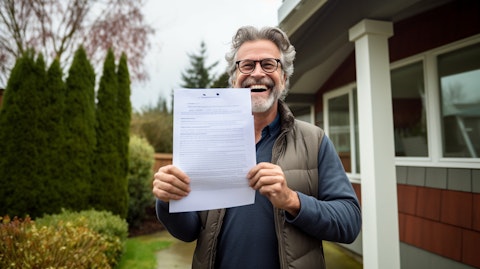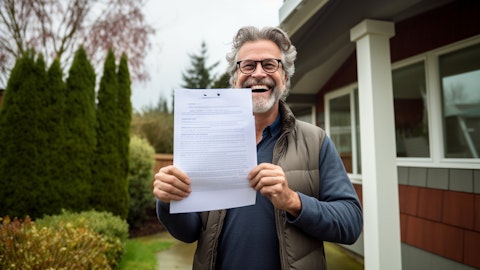HCI Group, Inc. (NYSE:HCI) Q4 2023 Earnings Call Transcript March 7, 2024
HCI Group, Inc. beats earnings expectations. Reported EPS is $3.22, expectations were $1.41. HCI isn’t one of the 30 most popular stocks among hedge funds at the end of the third quarter (see the details here).
Operator: Good afternoon and welcome to HCI Group’s Fourth Quarter 2023 Earnings Call. My name is John, and I will be your conference operator. At this time, all participants will be in a listen-only mode. Before we begin today’s call, I would like to remind everyone that this conference call is being recorded and will be available for replay through April 6, 2024, starting later today. The call is also being broadcast live via webcast and available via webcast replay until March 7, 2024, on the Investor Information section of HCI Group’s website at www.hcigroup.com. I would now like to turn the call over to Matt Glover, Gateway Investor Relations. Matt, please proceed.
Matt Glover: Thank you, John, and good afternoon, everyone. Welcome to HCI Group’s fourth quarter 2023 earnings call. On today’s call is Karin Coleman, HCI’s Chief Operating Officer; Mark Harmsworth, HCI’s Chief Financial Officer; and Paresh Patel, HCI’s Chairman and Chief Executive Officer. Following Karin’s operational update, Mark will review our financial performance for the fourth quarter of 2023, and then Paresh will provide a strategic update. To access today’s webcast, please visit the Investor Information section of our corporate website at www.hcigroup.com. Before we begin, I would like to take the opportunity to remind our listeners that today’s presentation and responses to questions may contain forward-looking statements made pursuant to the Private Securities Litigation Reform Act of 1995.
Words such as anticipate, estimate, expect, intend, plan and project and other similar words and expressions are intended to signify forward-looking statements. Forward-looking statements are not guarantees of future results and conditions but rather are subject to various risks and uncertainties. Some of these risks and uncertainties are identified in the company’s filings with the Securities and Exchange Commission. Should any risks or uncertainties develop into actual events, these developments could have material adverse effects on the company’s business, financial conditions and results of operations. HCI Group disclaims all the obligations to update any forward-looking statements. Now, with that, I would like to turn the call over to Karin Coleman, Chief Operating Officer.
Karin?
Karin Coleman: Thank you, Matt and welcome everyone. HCI Group wrapped up 2023 by reporting another excellent quarter, with pre-tax income of $54.2 million and diluted earnings per share of $3.40. In-force premiums increased 30% in the quarter to approximately $1 billion. Similar to prior quarters, each of our business segments had a positive contribution to our results. At our insurance division, Homeowners Choice generated another quarter of consistent earnings, and TypTap Insurance Group reported its fourth straight quarter of GAAP profitability. HCI continued to deliver on its commitment to shareholders, paying a dividend of $0.40 per share, our 53rd consecutive quarterly dividend. On our last earnings call in November, we discussed several initiatives underway.
They included both of our existing carriers were in the process of assuming policies from Citizens. We said we expected those to total between $150 million to $250 million of in-force premium. I’m pleased to announce we completed three depopulations from Citizens, totaling $273 million of in-force premium. We also spoke about plans to form a new reciprocal carrier to be named Condo Owners Reciprocal Exchange, or CORE for short, with the intention of it writing commercial residential insurance in Florida. In five months, CORE went from being a concept to now being a fully licensed carrier with a Demotech rating, has fully placed its reinsurance, and last week completed its first Citizens assumption of $38 million of in-force premium. This is in addition to the $273 million I just mentioned.
CORE also has been approved for an April assumption and has applied for a June assumption as well. I look forward to providing updates on these in the future. In addition to these significant accomplishments, we took an opportunity to retire the Centerbridge preferred shares and TypTap a year ahead of schedule. We also successfully raised $85 million through a common stock offering. To summarize, in a few short months, we were able to add a significant amount of premium, improve our gross loss ratio, launch a new carrier, and simplify our balance sheet. Now I’ll turn it over to Mark to provide more details on our financial results.
Mark Harmsworth: Thanks. So as Karin mentioned, this was another really good quarter for the company. Pre-tax income was over $54 million for the quarter and $117 million for the year. Diluted earnings per share were $3.40 for the quarter and $7.62 for the year. These results reflect the continuing positive direction we’ve been discussing for a while now, growing premiums, higher investment income, better loss trends, and expense management. Gross premiums earned were 18% higher than the same quarter last year, driven by higher average premium per policy and enhanced by the takeouts we’ve done with Citizens. While the full impact of these takeouts is not yet reflected in earned premium, they did add $23 million of earned premium in the quarter.

Investment income was about 50% higher than in the fourth quarter than the same quarter last year. When interest rates were low, we held on to our cash, and now we are seeing the benefits of careful duration management. Cash and fixed term investments now total over $1 billion, and we have positioned the portfolio to generate impressive yields with minimum capital risk. Another positive trend you can see in our results is the continued improvement in the gross loss ratio, which was 30.4% in the fourth quarter, down from 39.4% in the same quarter last year. When the Florida legislative changes were announced, we said we expected the consolidated gross loss ratios to drop from 40% to 30%, and that’s exactly what’s happened. We got here through careful underwriting and rate actions, along with lower claims and litigation frequency.
We’re not getting to these lower loss ratios by reducing reserves. In fact, net reserves at the end of 2023 are higher than at the end of 2022. If you looked at the balance sheet, you might notice that total reserves are lower than a year ago, but those are gross reserves. They’re down for two reasons. First, because of the payments made on storms like Ian and Irma, and second, because we have significantly reduced the ultimate expected loss for Hurricane Ian. Originally, back in September of 2022, we set the ultimate expected loss for Ian based on the models at $960 million. At the end of 2022, we lowered that to $845 million, and at the end of 2023, we lowered it again down to $740 million. While we have lowered the ultimate by more than $200 million to date, we are still at the top of the actuaries range for this storm.
The last trend I wanted to mention relates to expenses. If you look at the combination of labor, policy acquisition, and operating expenses, they’re flat quarter-over-quarter, and as a percentage of premiums, they’re down as we continue to manage expenses. The company is growing, but our expenses are not. Along with the declining loss ratios, expense management is driving significant improvement in the combined ratio, which was 85% for the full year. Now that I’ve talked about improvements to the income statement, I should also talk about improvements to the balance sheet and liquidity driven by profitability, debt management, and capital management. As you know, we raised $85 million of new equity during the fourth quarter, issuing 1,150,000 new shares.
We also expanded the capacity of our credit facility with Fifth Third Bank from $50 million to $75 million during the quarter. As of December 31, 2023, we had just over $215 million of cash and financial investments at the holding company level, and when combined with the credit facility, about $290 million of total holding company liquidity. This is about $100 million higher than it was a year ago. As Karin mentioned, there are a couple of other capital transactions that have happened since the year-end. First, we redeemed the preferred shares owned by Centerbridge, and second, we began the process of converting the balance of our 4.25% convertible notes into common to be completed by the end of the first quarter. A couple of other numbers to mention, book value per share continues to grow.
During 2023, book value per share increased from $18.91 to $33.36. Our debt to capital ratio has also improved considerably. At the end of 2022, it was just over 65%, and at the end of 2023, it was down to 48%. With the transactions happening in the first quarter of 2024, this should reduce further. By the end of the first quarter of 2024, we expect the debt to cap ratio to be under 40%. To summarize, the fourth quarter was a great ending to a really strong year. Revenue is growing, expenses are not, the balance sheet is improving, and so is our holding company liquidity. We’ve positioned ourselves well, and we look forward to the coming year. With that, I’ll hand it over to Paresh.
Paresh Patel: Thank you, Mark. Sometimes the numbers just speak for themselves. Karin talked about the multiple operational achievements over the last five months. Mark provided an update on the financial impact of these achievements, both to the income statement as well as to the balance sheet. Each of these items completed successfully is great just by itself. The fact that we managed to do all of them at the same time is really something. This is possible because of our people and the technology that we have developed. The net result of this is that we crossed the billion dollars in-force premium, which is a major milestone, and with record earnings. Stepping back from the numbers for a moment, our actions have impacted not only our shareholders, but our policyholders as well.
We now provide coverage to the most policyholders in our history. The steps we took helped to improve market conditions and reduce insurance anxiety in Florida. Through our depopulation efforts, as well as forming new carriers, we have helped the situation. Citizens is still too large with over 1.1 million policies, but it is smaller today than at any time in 2023. We look forward to help shrink it further. And the events of the last five months were not impossible. When prudent preparation and planning meet the right opportunity, and if you know how to execute successfully, that is exactly what we have done. In closing, while Q4 2023 was our best quarter so far, it is only our best quarter so far. With that, we will open for questions. Operator, please provide the instructions.
Operator: Thank you, sir. At this time, we will be conducting a question-and-answer session. [Operator Instructions] The first question comes from Matt Carletti with Citizens JMP. Please proceed.
See also 25 Fastest Growing Real Estate Markets in the World and 15 Mailchimp Alternatives for Email Newsletters in 2024.
Q&A Session
Follow Hci Group Inc. (NYSE:HCI)
Follow Hci Group Inc. (NYSE:HCI)
Matthew Carletti: Hey, thanks. Good afternoon.
Paresh Patel: Hey, Matt. Good afternoon.
Matthew Carletti: Good afternoon. Paresh, your last comment there, you gave us a little peek into your continued appetite for business and to grow in Florida. Can you give us a broader picture of what the competitive landscape looks like and maybe how that might have changed, if at all, over the past three, six months?
Paresh Patel: Sure, Matt. So, what has happened is we started carriers last year. We’ve done depopulations. We were very successful at it in the sense of when we made offers, over 70% of people accepted the offers. All of this was very successful. And we watched the competitive landscape as a whole. And we noticed that there are a lot more depopulations occurring now. I think there are depopulations happening all throughout the year, all the way to June at the moment. So, all of these are very positive things. There are other carriers who have stepping up to depopulate for the first time ever. So, these are all positive signs, building on the things that Mark talked about last year, that litigation reform that was passed will have an effect.
We’re seeing everybody else vote with us that that is occurring. Having said all of that, I also want to make sure that we understand where we sit. Citizens, which had swelled to — those expectations, they would swell to almost 2 million policies by the end of 2023, has started to shrink. It is now about the same size as it was at the end of 2022. Right? So, the depopulation impacts are having an effect on the size of Citizens. It’s still very big, 1.1 million. So, there’s plenty of opportunity. But these are the first signs of a healthy market returning to Florida. And we’re glad we participated in it.
Matthew Carletti: Great. Can you give us any more color on — I mean, Karin, you commented on CORE, the $34 million in-force assumption, I guess, last week, and mentioned, April approved, I think, filing for May. Can you give us any indication of kind of potential size of those assumptions?
Paresh Patel: Hey, Matt, let me take that one as well. When we started CORE, given its capital funding, et cetera, we are trying — our initial objective was to grow it to about $75 million of in-force premium. So, 38 is a very good step towards that. The April and June depopulations will sort of top us up to the number that we want to see. And we’ve already bought reinsurance for all of that. So, CORE is up and running and healthy.
Matthew Carletti: Great. And then just a couple numbers questions, probably for Mark, but for anybody. TypTap surplus at year-end, as well as what was gross written premium for TypTap for the year?
Mark Harmsworth: So, surplus for TypTap is $92.5 million. And what was the other question, Matt?
Matthew Carletti: It was gross written premiums at TypTap for full year ’23.
Mark Harmsworth: For the full year, hang on a second, TypTap was full year $363 million.
Matthew Carletti: Awesome. Thank you very much. Congrats on a really nice quarter of a year. Thanks for the answers.
Mark Harmsworth: Yeah. Thanks, Matt.
Paresh Patel: Thanks.
Operator: The next question comes from Michael Phillips with Oppenheimer. Please proceed.
Michael Phillips: Thanks. Good afternoon, everybody. I guess maybe just a high-level question. Paresh, for your growth loss ratio, which I mean, you guys talked, you expected to be around 30, given what’s happening in Florida. But why target for such a low ratio that’s clearly, light years ahead of anybody else in the state or anybody else in the freaking country? Are you — do you feel like you leave money on the table for growth if you are shooting for such a low loss ratio? And it’s probably even some conservatism in that, I assume, given what you’re doing to your reserves.
Paresh Patel: Good question. I think the growth loss ratio, and just for the sake of it, so it follows along, we define that as our total losses that net loss is divided by gross premium. That low partly because some of it’s because of Florida. But the reason we also do that is it’s just how well our technology works, right? We charge a market competitive premium. It’s just that our technology is so great, sorry, I’m bragging about it at this point, that it picks the right policies and we’ve curated a set of policy orders now who — they file a claim when they have to, but they don’t file a claim when they don’t have to, and it creates a better stable outcome, right? It’s just been one of those things. The other side of this also, it’s a moment in time because when Mark a year ago was talking about the loss ratio going from 40 to 30, right, it seemed like a very big lift that that would occur.
And here we are, done and dusted. So that’s the item of where we sit, right? It’s something we aspire to and once in a while we achieve it, which is a great thing.
Michael Phillips: So, is it harder to get those policies that you talked about that have such great loss ratios? Is it harder to get that same kind of client base the more you expand that technology outside of Florida?
Paresh Patel: Actually, let me try to see if I can explain in a slightly different way, right? And we actually talked about this, about what’s going on inside Citizens, right? So Citizens has 1.1 million policies in it, yeah? And when you look at those policies, you just see 1.1 million policies. What our technology allows us to do is very quickly look at all of those homes and we think of them as red houses and green houses. We’ve talked about this before, right? Green houses are ones that if you take at current prices and keep them for let’s say 100 years, it will be a profitable outcome. Red houses are ones that won’t be profitable and it could be a combination of things. Reinsurance cost is too high or losses will be too high or premiums too low, any number of reasons, the computers decide what’s green and what’s red.


